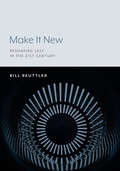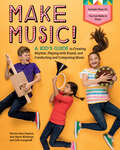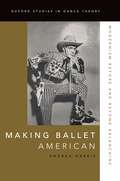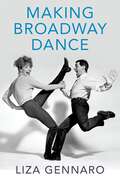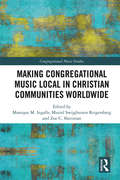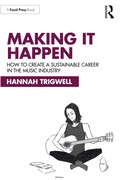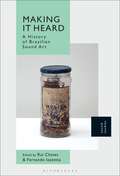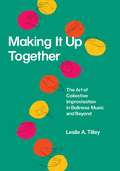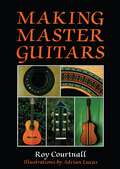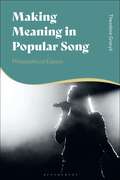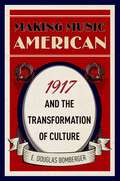- Table View
- List View
Make Arts for a Better Life: A Guide for Working with Communities
by Brian Schrag Kathleen Van BurenMake Arts for a Better Life: A Guide for Working with Communities provides a ground-breaking model for arts advocacy. Drawing upon methods and theories from disciplines such as ethnomusicology, anthropology, folklore, community development, and communication studies, the Guide presents an in-depth approach to researching artistic practices within communities and to developing arts-based projects that address locally-defined needs. Through clear methodology, case studies from around the world, and sample activities, the Guide helps move readers from arts research to project development to project evaluation. Woven into the discussions are critical reflections on the concept of a "better life" and ethical issues in arts advocacy. Accessible writing and visual cues ensure that readers can easily locate sections which may be particularly pertinent to their work, whether based on types of arts (music, drama, dance, oral verbal arts, visual arts) or professional positions (educators, scholars, project leaders). For additional resources, readers can access an accompanying website offering methodology "cheat sheets," sample research documents, and suggestions for educators, scholars, and project leaders.
Make Arts for a Better Life: A Guide for Working with Communities
by Kathleen Van Buren Brian SchragMake Arts for a Better Life: A Guide for Working with Communities provides a ground-breaking model for arts advocacy. Drawing upon methods and theories from disciplines such as ethnomusicology, anthropology, folklore, community development, and communication studies, the Guide presents an in-depth approach to researching artistic practices within communities and to developing arts-based projects that address locally-defined needs. Through clear methodology, case studies from around the world, and sample activities, the Guide helps move readers from arts research to project development to project evaluation. Woven into the discussions are critical reflections on the concept of a "better life" and ethical issues in arts advocacy. Accessible writing and visual cues ensure that readers can easily locate sections which may be particularly pertinent to their work, whether based on types of arts (music, drama, dance, oral verbal arts, visual arts) or professional positions (educators, scholars, project leaders). For additional resources, readers can access an accompanying website offering methodology "cheat sheets," sample research documents, and suggestions for educators, scholars, and project leaders.
Make It New: Reshaping Jazz in the 21st Century
by Bill BeuttlerAs jazz enters its second century it is reasserting itself as dynamic and relevant. Boston Globe jazz writer and Emerson College professor Bill Beuttler reveals new ways in which jazz is engaging with society through the vivid biographies and music of Jason Moran, Vijay Iyer, Rudresh Mahanthappa, The Bad Plus, Miguel Zenón, Anat Cohen, Robert Glasper, and Esperanza Spalding. These musicians are freely incorporating other genres of music into jazz—from classical (both western and Indian) to popular (hip-hop, R&B, rock, bluegrass, klezmer, Brazilian choro)—and other art forms as well (literature, film, photography, and other visual arts). This new generation of jazz is increasingly more international and is becoming more open to women as instrumentalists and bandleaders. Contemporary jazz is reasserting itself as a force for social change, prompted by developments such as the Black Lives Matter, #MeToo movements, and the election of Donald Trump.
Make Music!: A Kid's Guide to Creating Rhythm, Playing with Sound, and Conducting and Composing Music
by Norma Jean Haynes Ann Sayre Wiseman John LangstaffThis book puts the &“play&” back in music with inventive ideas for simple homemade instruments and creative instructions for orchestrating sound and rhythm with delightful results — no prior musical experience required!
Make Some Noise: The mind-blowing guide to all things music by the world’s funniest band
by The Horne Section*The funniest band in the world, The Horne Section (fronted by Taskmaster's Alex Horne), tell you everything you need to know to be a music genius - with bizarre tales, absurd history and unbelievable facts.*'An explosion of silliness . . the whole family will get something from it' Guardian on The Horne Section TV showWith FUNNY tales, ABSURD history and UNBELIEVABLE facts, this mind-blowing guide to music can help anyone become a sound-making sensation.In this book, you'll find answers to those all-important questions, such as:- Why is cabbage the key to musical genius?- Which is the fartiest of all the instruments?- Which song has the FUNNIEST lyrics of all time?Band leader Alex Horne has also added some special tasks throughout the book, so readers will be making their own music in no time at all - without even leaving the house!
Making Ballet American: Modernism Before and Beyond Balanchine (Oxford Studies in Dance Theory)
by Andrea HarrisGeorge Balanchine's arrival in the United States in 1933, it is widely thought, changed the course of ballet history by creating a bold neoclassical style that is celebrated as the first American manifestation of the art form. In Making Ballet American, author Andrea Harris challenges this narrative by revealing the complex social, cultural, and political forces that actually shaped the construction of American neoclassical ballet. Situating American ballet within a larger context of modernisms, the book examines critical efforts to craft new, modernist ideas about the relevance of classical dancing for American society and democracy. Through cultural and choreographic analysis, it illustrates the evolution of modernist ballet during a turbulent historical period. Ultimately, the book argues that the Americanization of Balanchine's neoclassicism was not the inevitable outcome of his immigration or his creative genius, but rather a far more complicated story that pivots on the question of modern art's relationship to America and the larger world.
MAKING BALLET OSDT C: Modernism Before and Beyond Balanchine (Oxford Studies in Dance Theory)
by Andrea HarrisGeorge Balanchine's arrival in the United States in 1933, it is widely thought, changed the course of ballet history by creating a bold neoclassical style that is celebrated as the first American manifestation of the art form. In Making Ballet American, author Andrea Harris challenges this narrative by revealing the complex social, cultural, and political forces that actually shaped the construction of American neoclassical ballet. Situating American ballet within a larger context of modernisms, the book examines critical efforts to craft new, modernist ideas about the relevance of classical dancing for American society and democracy. Through cultural and choreographic analysis, it illustrates the evolution of modernist ballet during a turbulent historical period. Ultimately, the book argues that the Americanization of Balanchine's neoclassicism was not the inevitable outcome of his immigration or his creative genius, but rather a far more complicated story that pivots on the question of modern art's relationship to America and the larger world.
Making Broadway Dance
by Liza GennaroThrough in-depth analysis of musical theatre choreography and choreographers, Making Broadway Dance challenges long-held perceptions of Broadway dance as kitsch, disposable, a dance form created without artistic process. Setting out to demonstrate that musical theatre dance is not a monolith but rather multi-varied in terms of dance styles, aesthetics and methodologies, author Liza Gennaro provides insights into how Broadway dance is made. By examining choreography for musical theatre through the lens of dance studies, script analysis, movement research and dramaturgical inquiry, she treads in uncharted territory by offering a close examination of a dance form that has heretofore received only the most superficial interrogation. She also explores how musical theatre choreographers create within the parameters of librettos, enhance character development and build dance languages that inform and propel narrative. By considering influences from ballet, modern, postmodern, Jazz, social and global dance, she reveals a rich understanding of musical theatre dance. This book exposes the choreographic systems of some of Broadway's most influential dance-makers including George Balanchine, Agnes de Mille, Jerome Robbins, Katherine Dunham, Bob Fosse, Savion Glover, Sergio Trujillo, Steven Hoggett and Camille Brown, and is essential reading for theatre and dance scholars, students, practitioners, and Broadway fans.
Making Broadway Dance
by Liza GennaroThrough in-depth analysis of musical theatre choreography and choreographers, Making Broadway Dance challenges long-held perceptions of Broadway dance as kitsch, disposable, a dance form created without artistic process. Setting out to demonstrate that musical theatre dance is not a monolith but rather multi-varied in terms of dance styles, aesthetics and methodologies, author Liza Gennaro provides insights into how Broadway dance is made. By examining choreography for musical theatre through the lens of dance studies, script analysis, movement research and dramaturgical inquiry, she treads in uncharted territory by offering a close examination of a dance form that has heretofore received only the most superficial interrogation. She also explores how musical theatre choreographers create within the parameters of librettos, enhance character development and build dance languages that inform and propel narrative. By considering influences from ballet, modern, postmodern, Jazz, social and global dance, she reveals a rich understanding of musical theatre dance. This book exposes the choreographic systems of some of Broadway's most influential dance-makers including George Balanchine, Agnes de Mille, Jerome Robbins, Katherine Dunham, Bob Fosse, Savion Glover, Sergio Trujillo, Steven Hoggett and Camille Brown, and is essential reading for theatre and dance scholars, students, practitioners, and Broadway fans.
Making Congregational Music Local in Christian Communities Worldwide (Congregational Music Studies Series)
by Monique M. Ingalls Muriel Swijghuisen Reigersberg Zoe C. SherinianWhat does it mean for music to be considered local in contemporary Christian communities, and who shapes this meaning? Through what musical processes have religious beliefs and practices once ‘foreign’ become ‘indigenous’? How does using indigenous musical practices aid in the growth of local Christian religious practices and beliefs? How are musical constructions of the local intertwined with regional, national or transnational religious influences and cosmopolitanisms? Making Congregational Music Local in Christian Communities Worldwide explores the ways that congregational music-making is integral to how communities around the world understand what it means to be ‘local’ and ‘Christian’. Showing how locality is produced, negotiated, and performed through music-making, this book draws on case studies from every continent that integrate insights from anthropology, ethnomusicology, cultural geography, mission studies, and practical theology. Four sections explore a central aspect of the production of locality through congregational music-making, addressing the role of historical trends, cultural and political power, diverging values, and translocal influences in defining what it means to be ‘local’ and ‘Christian’. This book contends that examining musical processes of localization can lead scholars to new understandings of the meaning and power of Christian belief and practice.
Making Congregational Music Local in Christian Communities Worldwide (Congregational Music Studies Series)
by Monique M. Ingalls Muriel Swijghuisen Reigersberg Zoe C. SherinianWhat does it mean for music to be considered local in contemporary Christian communities, and who shapes this meaning? Through what musical processes have religious beliefs and practices once ‘foreign’ become ‘indigenous’? How does using indigenous musical practices aid in the growth of local Christian religious practices and beliefs? How are musical constructions of the local intertwined with regional, national or transnational religious influences and cosmopolitanisms? Making Congregational Music Local in Christian Communities Worldwide explores the ways that congregational music-making is integral to how communities around the world understand what it means to be ‘local’ and ‘Christian’. Showing how locality is produced, negotiated, and performed through music-making, this book draws on case studies from every continent that integrate insights from anthropology, ethnomusicology, cultural geography, mission studies, and practical theology. Four sections explore a central aspect of the production of locality through congregational music-making, addressing the role of historical trends, cultural and political power, diverging values, and translocal influences in defining what it means to be ‘local’ and ‘Christian’. This book contends that examining musical processes of localization can lead scholars to new understandings of the meaning and power of Christian belief and practice.
Making It Happen: How to Create a Sustainable Career in the Music Industry
by Hannah TrigwellMaking It Happen is a comprehensive guide to navigating the modern music industry, that redefines what ‘making it’ means for musicians, and inspires and educates musicians on the different options for generating revenue from their art. This book offers theoretical and practical advice on making music, creating promotional content and embracing traditional and emerging social media platforms into your marketing strategies. Through interviews with music industry experts, readers can expect professional tips and advice, as well as clear instructions on how to build a dream team, make content, share that work and grow an audience to enable long-term business sustainability. In the modern music industry, having multiple revenue streams leads to a stable income. Making It Happen offers unique insights into the innovations and technologies available to contemporary music makers, making it essential reading for independent musicians, music business students, music producers and marketers.
Making It Happen: How to Create a Sustainable Career in the Music Industry
by Hannah TrigwellMaking It Happen is a comprehensive guide to navigating the modern music industry, that redefines what ‘making it’ means for musicians, and inspires and educates musicians on the different options for generating revenue from their art. This book offers theoretical and practical advice on making music, creating promotional content and embracing traditional and emerging social media platforms into your marketing strategies. Through interviews with music industry experts, readers can expect professional tips and advice, as well as clear instructions on how to build a dream team, make content, share that work and grow an audience to enable long-term business sustainability. In the modern music industry, having multiple revenue streams leads to a stable income. Making It Happen offers unique insights into the innovations and technologies available to contemporary music makers, making it essential reading for independent musicians, music business students, music producers and marketers.
Making It Heard: A History of Brazilian Sound Art
by Rui Chaves Fernando IazzettaFrom the mid-20th century to present, the Brazilian art, literature, and music scene have been witness to a wealth of creative approaches involving sound. This is the backdrop for Making It Heard: A History of Brazilian Sound Art, a volume that offers an overview of local artists working with performance, experimental vinyl production, sound installation, sculpture, mail art, field recording, and sound mapping. It criticizes universal approaches to art and music historiography that fail to recognize local idiosyncrasies, and creates a local rationale and discourse. Through this approach, Chaves and Iazzetta enable students, researchers, and artists to discover and acknowledge work produced outside of a standard Anglo-European framework.
Making It Heard: A History of Brazilian Sound Art
From the mid-20th century to present, the Brazilian art, literature, and music scene have been witness to a wealth of creative approaches involving sound. This is the backdrop for Making It Heard: A History of Brazilian Sound Art, a volume that offers an overview of local artists working with performance, experimental vinyl production, sound installation, sculpture, mail art, field recording, and sound mapping. It criticizes universal approaches to art and music historiography that fail to recognize local idiosyncrasies, and creates a local rationale and discourse. Through this approach, Chaves and Iazzetta enable students, researchers, and artists to discover and acknowledge work produced outside of a standard Anglo-European framework.
Making It Up Together: The Art of Collective Improvisation in Balinese Music and Beyond (Chicago Studies in Ethnomusicology)
by Leslie A. TilleyMost studies of musical improvisation focus on individual musicians. But that is not the whole story. From jazz to flamenco, Shona mbira to Javanese gamelan, improvised practices thrive on group creativity, relying on the close interaction of multiple simultaneously improvising performers. In Making It Up Together, Leslie A. Tilley explores the practice of collective musical improvisation cross-culturally, making a case for placing collectivity at the center of improvisation discourse and advocating ethnographically informed music analysis as a powerful tool for investigating improvisational processes. Through two contrasting Balinese case studies—of the reyong gong chime’s melodic norot practice and the interlocking drumming tradition kendang arja—Tilley proposes and tests analytical frameworks for examining collectively improvised performance. At the micro-level, Tilley’s analyses offer insight into the note-by-note decisions of improvising performers; at the macro-level, they illuminate larger musical, discursive, structural, and cultural factors shaping those decisions. This multi-tiered inquiry reveals that unpacking how performers play and imagine as a collective is crucial to understanding improvisation and demonstrates how music analysis can elucidate these complex musical and interactional relationships. Highlighting connections with diverse genres from various music cultures, Tilley’s examinations of collective improvisation also suggest rich potential for cross-genre exploration. The surrounding discussions point to larger theories of communication and interaction, creativity and cognition that will be of interest to a range of readers—from ethnomusicologists and music theorists to cognitive psychologists, jazz studies scholars, and improvising performers. Setting new parameters for the study of improvisation, Making It Up Together opens up fresh possibilities for understanding the creative process, in music and beyond.
Making It Up Together: The Art of Collective Improvisation in Balinese Music and Beyond (Chicago Studies in Ethnomusicology)
by Leslie A. TilleyMost studies of musical improvisation focus on individual musicians. But that is not the whole story. From jazz to flamenco, Shona mbira to Javanese gamelan, improvised practices thrive on group creativity, relying on the close interaction of multiple simultaneously improvising performers. In Making It Up Together, Leslie A. Tilley explores the practice of collective musical improvisation cross-culturally, making a case for placing collectivity at the center of improvisation discourse and advocating ethnographically informed music analysis as a powerful tool for investigating improvisational processes. Through two contrasting Balinese case studies—of the reyong gong chime’s melodic norot practice and the interlocking drumming tradition kendang arja—Tilley proposes and tests analytical frameworks for examining collectively improvised performance. At the micro-level, Tilley’s analyses offer insight into the note-by-note decisions of improvising performers; at the macro-level, they illuminate larger musical, discursive, structural, and cultural factors shaping those decisions. This multi-tiered inquiry reveals that unpacking how performers play and imagine as a collective is crucial to understanding improvisation and demonstrates how music analysis can elucidate these complex musical and interactional relationships. Highlighting connections with diverse genres from various music cultures, Tilley’s examinations of collective improvisation also suggest rich potential for cross-genre exploration. The surrounding discussions point to larger theories of communication and interaction, creativity and cognition that will be of interest to a range of readers—from ethnomusicologists and music theorists to cognitive psychologists, jazz studies scholars, and improvising performers. Setting new parameters for the study of improvisation, Making It Up Together opens up fresh possibilities for understanding the creative process, in music and beyond.
Making It Up Together: The Art of Collective Improvisation in Balinese Music and Beyond (Chicago Studies in Ethnomusicology)
by Leslie A. TilleyMost studies of musical improvisation focus on individual musicians. But that is not the whole story. From jazz to flamenco, Shona mbira to Javanese gamelan, improvised practices thrive on group creativity, relying on the close interaction of multiple simultaneously improvising performers. In Making It Up Together, Leslie A. Tilley explores the practice of collective musical improvisation cross-culturally, making a case for placing collectivity at the center of improvisation discourse and advocating ethnographically informed music analysis as a powerful tool for investigating improvisational processes. Through two contrasting Balinese case studies—of the reyong gong chime’s melodic norot practice and the interlocking drumming tradition kendang arja—Tilley proposes and tests analytical frameworks for examining collectively improvised performance. At the micro-level, Tilley’s analyses offer insight into the note-by-note decisions of improvising performers; at the macro-level, they illuminate larger musical, discursive, structural, and cultural factors shaping those decisions. This multi-tiered inquiry reveals that unpacking how performers play and imagine as a collective is crucial to understanding improvisation and demonstrates how music analysis can elucidate these complex musical and interactional relationships. Highlighting connections with diverse genres from various music cultures, Tilley’s examinations of collective improvisation also suggest rich potential for cross-genre exploration. The surrounding discussions point to larger theories of communication and interaction, creativity and cognition that will be of interest to a range of readers—from ethnomusicologists and music theorists to cognitive psychologists, jazz studies scholars, and improvising performers. Setting new parameters for the study of improvisation, Making It Up Together opens up fresh possibilities for understanding the creative process, in music and beyond.
Making It Up Together: The Art of Collective Improvisation in Balinese Music and Beyond (Chicago Studies in Ethnomusicology)
by Leslie A. TilleyMost studies of musical improvisation focus on individual musicians. But that is not the whole story. From jazz to flamenco, Shona mbira to Javanese gamelan, improvised practices thrive on group creativity, relying on the close interaction of multiple simultaneously improvising performers. In Making It Up Together, Leslie A. Tilley explores the practice of collective musical improvisation cross-culturally, making a case for placing collectivity at the center of improvisation discourse and advocating ethnographically informed music analysis as a powerful tool for investigating improvisational processes. Through two contrasting Balinese case studies—of the reyong gong chime’s melodic norot practice and the interlocking drumming tradition kendang arja—Tilley proposes and tests analytical frameworks for examining collectively improvised performance. At the micro-level, Tilley’s analyses offer insight into the note-by-note decisions of improvising performers; at the macro-level, they illuminate larger musical, discursive, structural, and cultural factors shaping those decisions. This multi-tiered inquiry reveals that unpacking how performers play and imagine as a collective is crucial to understanding improvisation and demonstrates how music analysis can elucidate these complex musical and interactional relationships. Highlighting connections with diverse genres from various music cultures, Tilley’s examinations of collective improvisation also suggest rich potential for cross-genre exploration. The surrounding discussions point to larger theories of communication and interaction, creativity and cognition that will be of interest to a range of readers—from ethnomusicologists and music theorists to cognitive psychologists, jazz studies scholars, and improvising performers. Setting new parameters for the study of improvisation, Making It Up Together opens up fresh possibilities for understanding the creative process, in music and beyond.
Making It Up Together: The Art of Collective Improvisation in Balinese Music and Beyond (Chicago Studies in Ethnomusicology)
by Leslie A. TilleyMost studies of musical improvisation focus on individual musicians. But that is not the whole story. From jazz to flamenco, Shona mbira to Javanese gamelan, improvised practices thrive on group creativity, relying on the close interaction of multiple simultaneously improvising performers. In Making It Up Together, Leslie A. Tilley explores the practice of collective musical improvisation cross-culturally, making a case for placing collectivity at the center of improvisation discourse and advocating ethnographically informed music analysis as a powerful tool for investigating improvisational processes. Through two contrasting Balinese case studies—of the reyong gong chime’s melodic norot practice and the interlocking drumming tradition kendang arja—Tilley proposes and tests analytical frameworks for examining collectively improvised performance. At the micro-level, Tilley’s analyses offer insight into the note-by-note decisions of improvising performers; at the macro-level, they illuminate larger musical, discursive, structural, and cultural factors shaping those decisions. This multi-tiered inquiry reveals that unpacking how performers play and imagine as a collective is crucial to understanding improvisation and demonstrates how music analysis can elucidate these complex musical and interactional relationships. Highlighting connections with diverse genres from various music cultures, Tilley’s examinations of collective improvisation also suggest rich potential for cross-genre exploration. The surrounding discussions point to larger theories of communication and interaction, creativity and cognition that will be of interest to a range of readers—from ethnomusicologists and music theorists to cognitive psychologists, jazz studies scholars, and improvising performers. Setting new parameters for the study of improvisation, Making It Up Together opens up fresh possibilities for understanding the creative process, in music and beyond.
Making It Up Together: The Art of Collective Improvisation in Balinese Music and Beyond (Chicago Studies in Ethnomusicology)
by Leslie A. TilleyMost studies of musical improvisation focus on individual musicians. But that is not the whole story. From jazz to flamenco, Shona mbira to Javanese gamelan, improvised practices thrive on group creativity, relying on the close interaction of multiple simultaneously improvising performers. In Making It Up Together, Leslie A. Tilley explores the practice of collective musical improvisation cross-culturally, making a case for placing collectivity at the center of improvisation discourse and advocating ethnographically informed music analysis as a powerful tool for investigating improvisational processes. Through two contrasting Balinese case studies—of the reyong gong chime’s melodic norot practice and the interlocking drumming tradition kendang arja—Tilley proposes and tests analytical frameworks for examining collectively improvised performance. At the micro-level, Tilley’s analyses offer insight into the note-by-note decisions of improvising performers; at the macro-level, they illuminate larger musical, discursive, structural, and cultural factors shaping those decisions. This multi-tiered inquiry reveals that unpacking how performers play and imagine as a collective is crucial to understanding improvisation and demonstrates how music analysis can elucidate these complex musical and interactional relationships. Highlighting connections with diverse genres from various music cultures, Tilley’s examinations of collective improvisation also suggest rich potential for cross-genre exploration. The surrounding discussions point to larger theories of communication and interaction, creativity and cognition that will be of interest to a range of readers—from ethnomusicologists and music theorists to cognitive psychologists, jazz studies scholars, and improvising performers. Setting new parameters for the study of improvisation, Making It Up Together opens up fresh possibilities for understanding the creative process, in music and beyond.
Making Master Guitars
by Roy CourtnallMaking Master Guitars is a craftsman's handbook about the exciting and challenging pursuit of making classical guitars, a craft that the author reveals to be surprisingly accessible by following his instructions. The book is unique in that it includes nine separate detailed plans of instruments constructed by internationally famous guitar-makers. The author has had the rare opportunity of examining these instruments in detail, and has made many replicas of each one. Superbly illustrated by Adrian Lucas. Part one: The Master Makers and their Guitars is devoted to separate chapters on each famous maker, including Antonio de Torres, Hermann Hauser, Santos Hernandez y Aguado, Ignacio Fleta, Robert Bouchet, Daniel Friederich and Jose Romanillos. The reader will find historical information about the life of and influences on each makers, as well as detailed sets of working drawings for their guitars. Also included are rare photographs of the guitars. Part two: Workshop, Tools and Materials provides essential information about the tools, working environment and material needed by the guitar-maker. Part three: Guitar Construction - The Spanish Method comprises a step-by-step method of guitar construction, illustrated by numerous photographs and drawings. The method of making a guitar is presented with great clarity. So that even the newcomer to this fascinating craft will be able to produce a superb instrument. This book will be essential for the guitar-maker and the historian, providing as it does a unique record of the different methods of guitar design and strutting systems that have evolved since Antonio de Torres first defined the essential characteristics of the modern classical guitar in the 1850s.
Making Meaning in Popular Song: Philosophical Essays
by Theodore GracykFor Theodore Gracyk meaning in popular music depends as much on the context of reception and performer's intentions as on established musical and semantic practices. Songs are structures that serve as the scaffolding for meaning production, influenced by the performance decisions of the performer and their intentions. Arguing against prevailing theories of meaning that ignore the power of the performance, Gracyk champions the contextual relevance of the performer as well as novel messaging through creative repurposing of recordings. Extending the philosophical insight that meaning is a function of use, Gracyk explains how both the performance persona and the personal life of a song's performer can contribute to (or undercut) ethical and political aspects of a performance or recording. Using Carly Simon's “You're So Vain”, Pink Floyd, the emergence of the musical genre of post-punk and the practice of “cover” versions, Gracyk explores the multiple, sometimes contradictory, notions of authenticity applied to popular music and the conditions for meaningful communication. He places popular music within larger cultural contexts and examines how assigning a performance or recording to one music genre rather than another has implications for what it communicates. Informed by a mix of philosophy of art and philosophy of language, Gracyk's entertaining study of popular music constructs a theoretical basis for a philosophy of meaning for songs.
Making Meaning in Popular Song: Philosophical Essays
by Theodore GracykFor Theodore Gracyk meaning in popular music depends as much on the context of reception and performer's intentions as on established musical and semantic practices. Songs are structures that serve as the scaffolding for meaning production, influenced by the performance decisions of the performer and their intentions. Arguing against prevailing theories of meaning that ignore the power of the performance, Gracyk champions the contextual relevance of the performer as well as novel messaging through creative repurposing of recordings. Extending the philosophical insight that meaning is a function of use, Gracyk explains how both the performance persona and the personal life of a song's performer can contribute to (or undercut) ethical and political aspects of a performance or recording. Using Carly Simon's “You're So Vain”, Pink Floyd, the emergence of the musical genre of post-punk and the practice of “cover” versions, Gracyk explores the multiple, sometimes contradictory, notions of authenticity applied to popular music and the conditions for meaningful communication. He places popular music within larger cultural contexts and examines how assigning a performance or recording to one music genre rather than another has implications for what it communicates. Informed by a mix of philosophy of art and philosophy of language, Gracyk's entertaining study of popular music constructs a theoretical basis for a philosophy of meaning for songs.
Making Music American: 1917 and the Transformation of Culture
by E. Douglas BombergerThe year 1917 was unlike any other in American history, or in the history of American music. The United States entered World War I, jazz burst onto the national scene, and the German musicians who dominated classical music were forced from the stage. As the year progressed, New Orleans natives Nick LaRocca and Freddie Keppard popularized the new genre of jazz, a style that suited the frantic mood of the era. African-American bandleader James Reese Europe accepted the challenge of making the band of the Fifteenth New York Infantry into the best military band in the country. Orchestral conductors Walter Damrosch and Karl Muck met the public demand for classical music while also responding to new calls for patriotic music. Violinist Fritz Kreisler, pianist Olga Samaroff, and contralto Ernestine Schumann-Heink gave American audiences the best of Old-World musical traditions while walking a tightrope of suspicion because of their German sympathies. Before the end of the year, the careers of these eight musicians would be upended, and music in America would never be the same. Making Music American recounts the musical events of this tumultuous year month by month from New Year's Eve 1916 to New Year's Day 1918. As the story unfolds, the lives of these eight musicians intersect in surprising ways, illuminating the transformation of American attitudes toward music both European and American. In this unsettled time, no one was safe from suspicion, but America's passion for music made the rewards high for those who could balance musical skill with diplomatic savvy.

